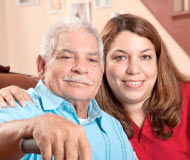
RN Kika Garcia-Awan’s care at home helped José S. recover from a stroke.
Read their story » During the month of April, the nation shines a spotlight on Parkinson's disease, a disorder of the brain that leads to shaking (tremors), difficulty with walking, movement, and coordination.
During the month of April, the nation shines a spotlight on Parkinson's disease, a disorder of the brain that leads to shaking (tremors), difficulty with walking, movement, and coordination.
According to the National Parkinson Foundation, there are an estimated 50,000 to 60,000 new cases of Parkinson's disease diagnosed each year, adding to the approximately one million people currently living with the condition in the United States.
Parkinson's disease is caused by the progressive impairment or deterioration of nerve cells in an area of the brain known as the substantia nigra. The links between Parkinson's disease and factors such as genetics, aging, toxins in the environment, and free radicals are all being studied, but why this occurs is still unknown.
Nerve cells use a brain chemical called dopamine to help control muscle movements. The characteristic symptoms of Parkinson's are caused when the nerve cells in the brain that make dopamine are slowed and destroyed. Without dopamine, the nerve cells cannot properly send messages. This leads to the loss of muscle function which gets worse over time.
According to the National Institute of Health, Parkinson's usually develops after the age of 50, although in some cases, it can occur in younger adults. The disease affects both men and women. There is no permanent cure for Parkinson's, however, new treatment options are helping people to live a better quality of life.
According to the National Parkinson Foundation, the following symptoms could indicate a Parkinson's disease diagnosis. Talk to your physician if you experience any of these symptoms. Your physician may perform diagnostic tests to rule out other disorders that could mimic the signs of Parkinson's.
Early warning signs include:
Although there is no known cure for Parkinson's, there are a number of medications available to help control symptoms. Your physician will determine the most appropriate medication and dosage based on your medical history, symptoms, and stage of the disease.
In addition, speech, occupational, and physical therapy can help people with Parkinson's learn to live with the symptoms of the disease. What's more, nurses, therapists, and home health aides can provide care in the home as needed, enabling those with the disease to avoid facility-based care, and the opportunity to live life to the fullest in comfort, safety, and dignity.
The National Institutes of Health also recommends talking to your physician about exercise, regular rest, and avoiding stress. Making nutrition and dietary changes can also help if you experience trouble swallowing.
For more information on Parkinson's disease, visit:
The Michael J. Fox Foundation for Parkinson's Research
If you or a loved one has been diagnosed with Parkinson's disease and want to know more about how care at home can help, contact BAYADA. We're happy to answer any questions you may have.

Chris S., who has Down Syndrome and uses a tracheostomy and ventilator to breathe, went to school every day with the help of his BAYADA Nurse.
Read their story »